Abstract
Mitoxantrone can be efficiently loaded into large unilamellar vesicles using a transmembrane pH gradient. Release studies indicate that these drug-loaded carriers are highly stable and even after dissipation of the residual pH gradient retain more than 85% of encapsulated mitoxantrone following dialysis at 37 degrees C for 5 days. In murine studies we have compared the plasma clearance and biodistribution of both mitoxantrone and liposomal lipid following intravenous administration of free drug or mitoxantrone encapsulated in either conventional or sterically stabilized liposomes. In contrast to the rapid blood clearance observed for free mitoxantrone, both liposomal systems provided extended circulation lifetimes, with over 90% of the drug present 1 h after administration and 15-30% remaining at 24 h. In agreement with previous reports, longer plasma half-lives were observed for sterically stabilized liposomes than for conventional systems. In addition, a strong correlation between drug and carrier biodistribution was seen, with uptake occurring mainly in the liver and spleen and paralleling plasma clearance. This would suggest that tissue disposition reflects that of drug-loaded liposomes rather than the individual components. Liposomal encapsulation also significantly reduced mitoxantrone toxicity, allowing administration of higher, more efficacious drug doses. In a murine L1210 tumour model, for example, no long-term survivors were seen in animal groups treated with free drug, whereas at the maximum therapeutic dose of liposomal mitoxantrone survival rates of 40% were observed.
Full text
PDF
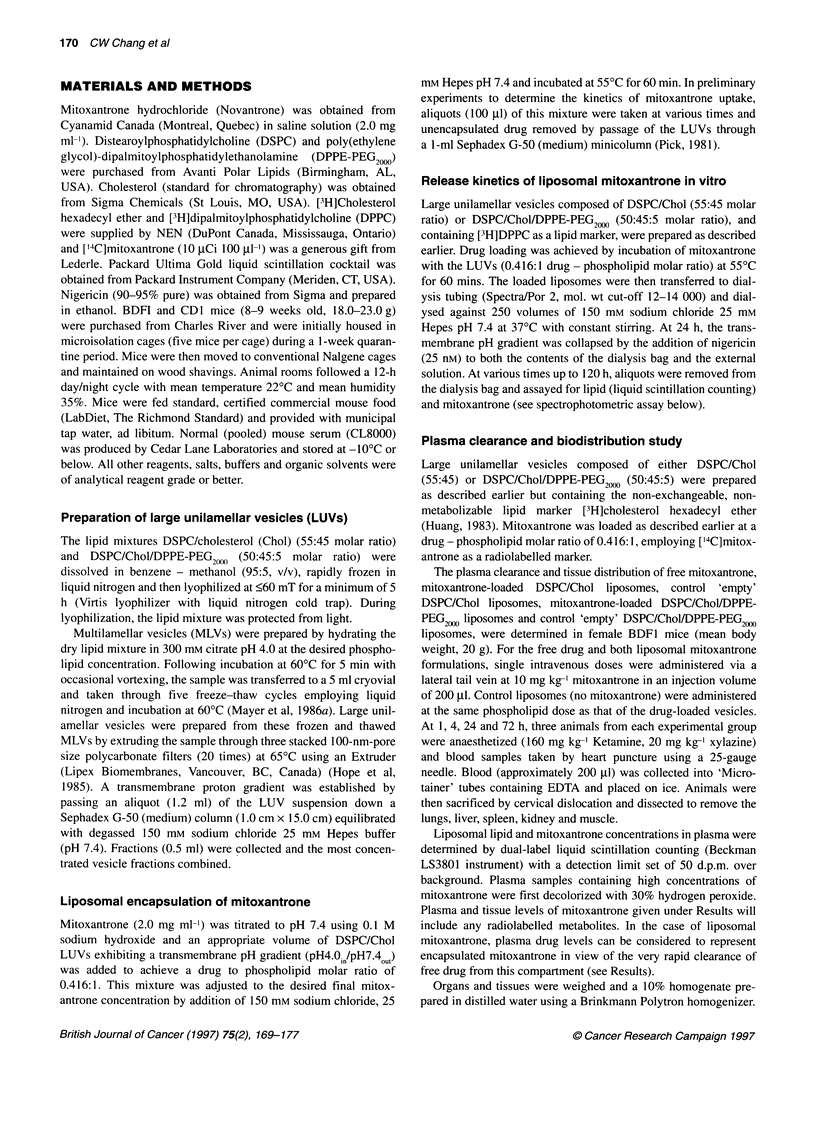
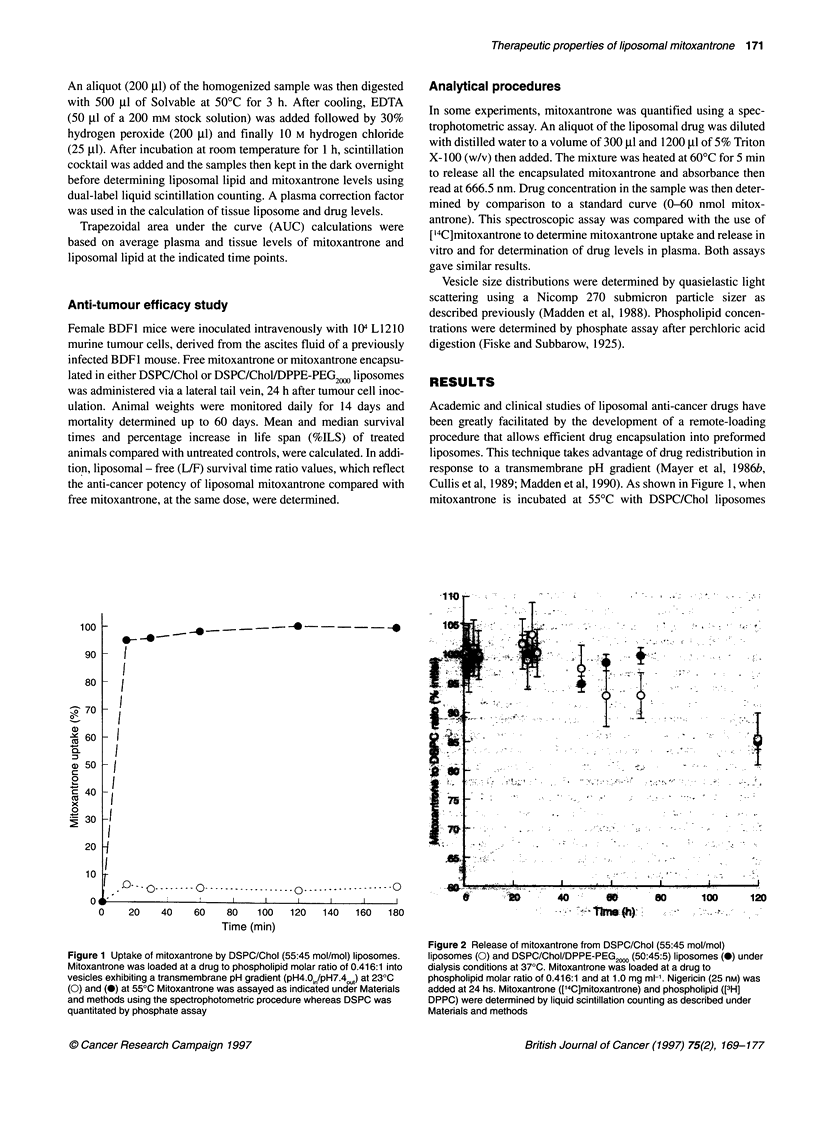
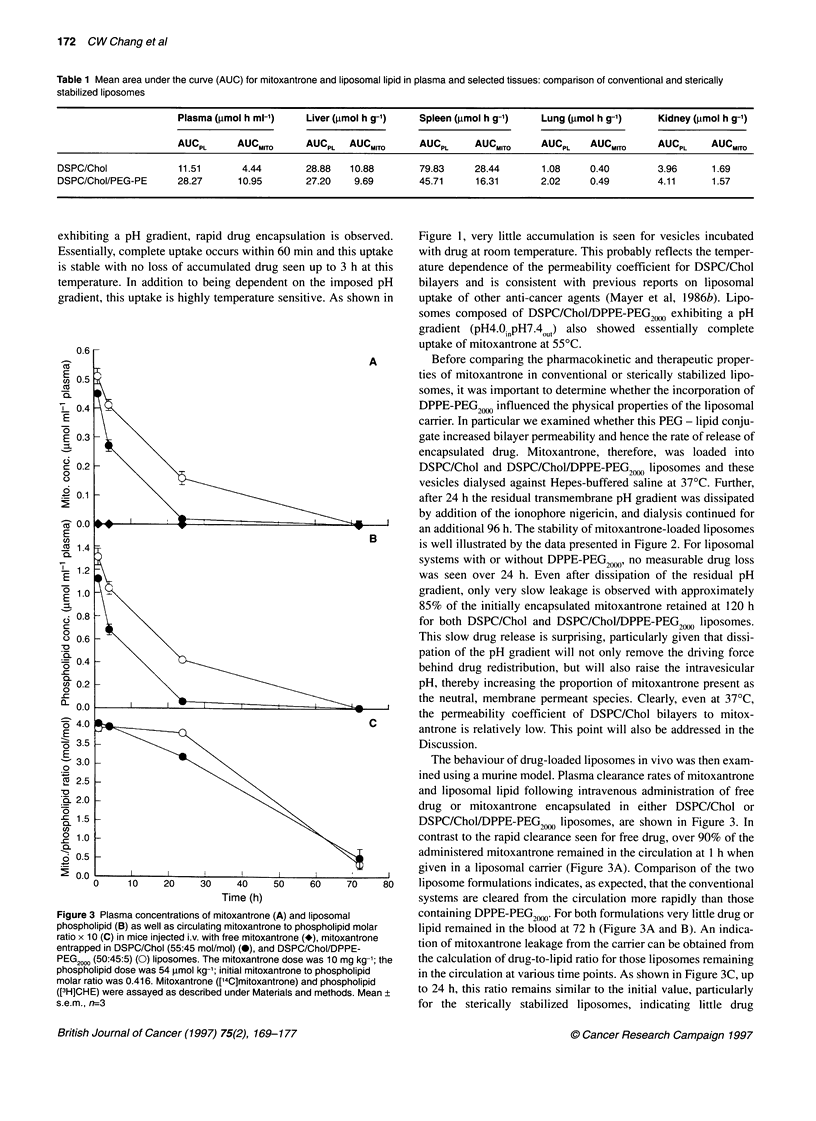
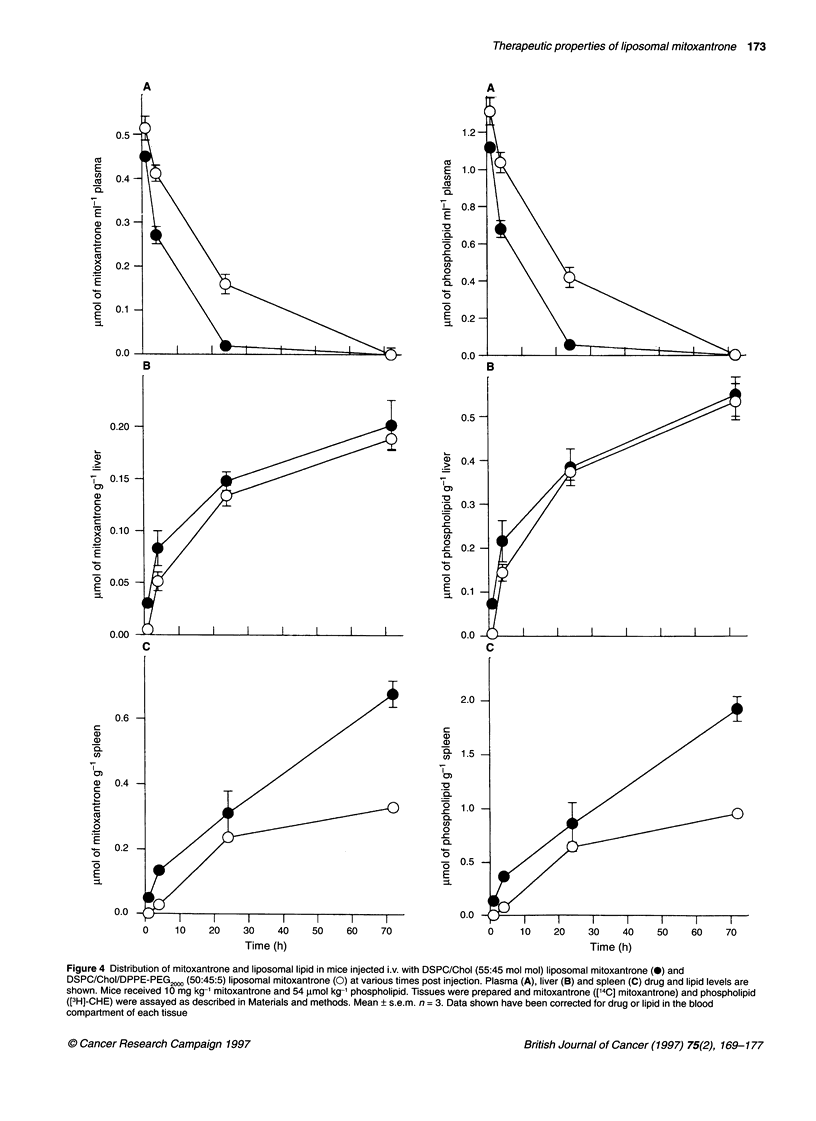
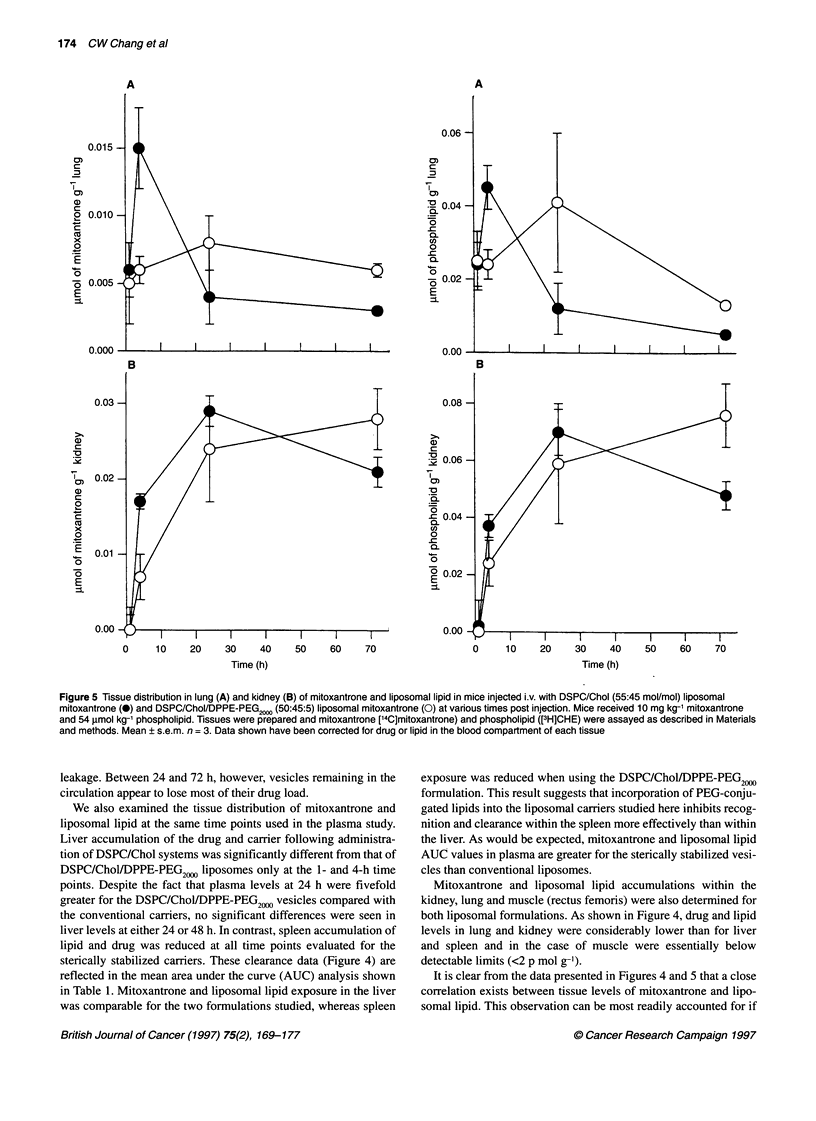
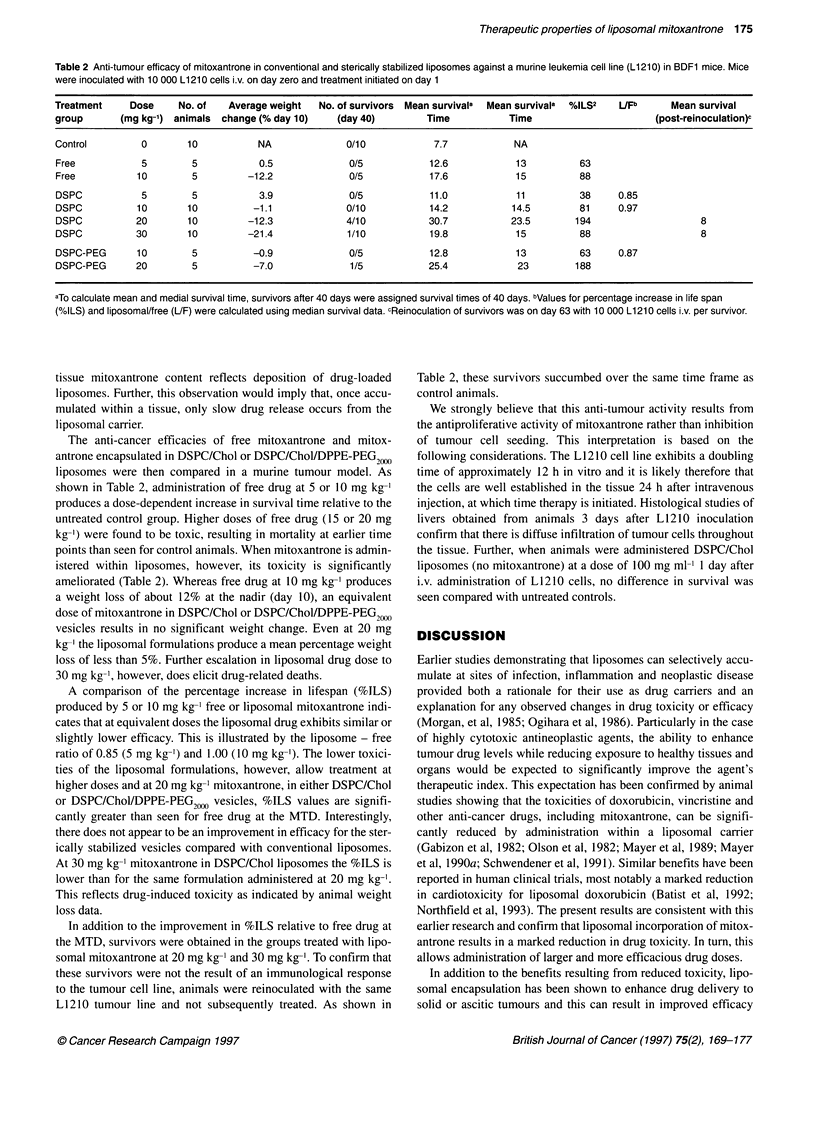
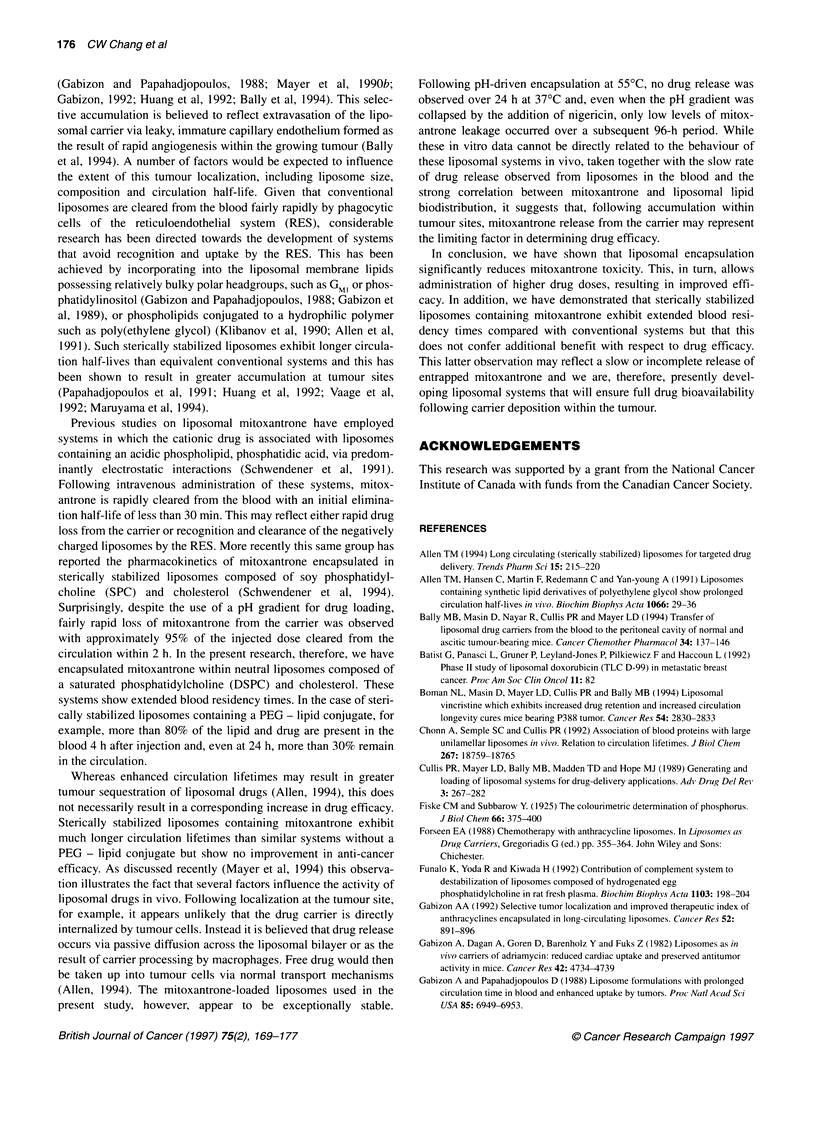
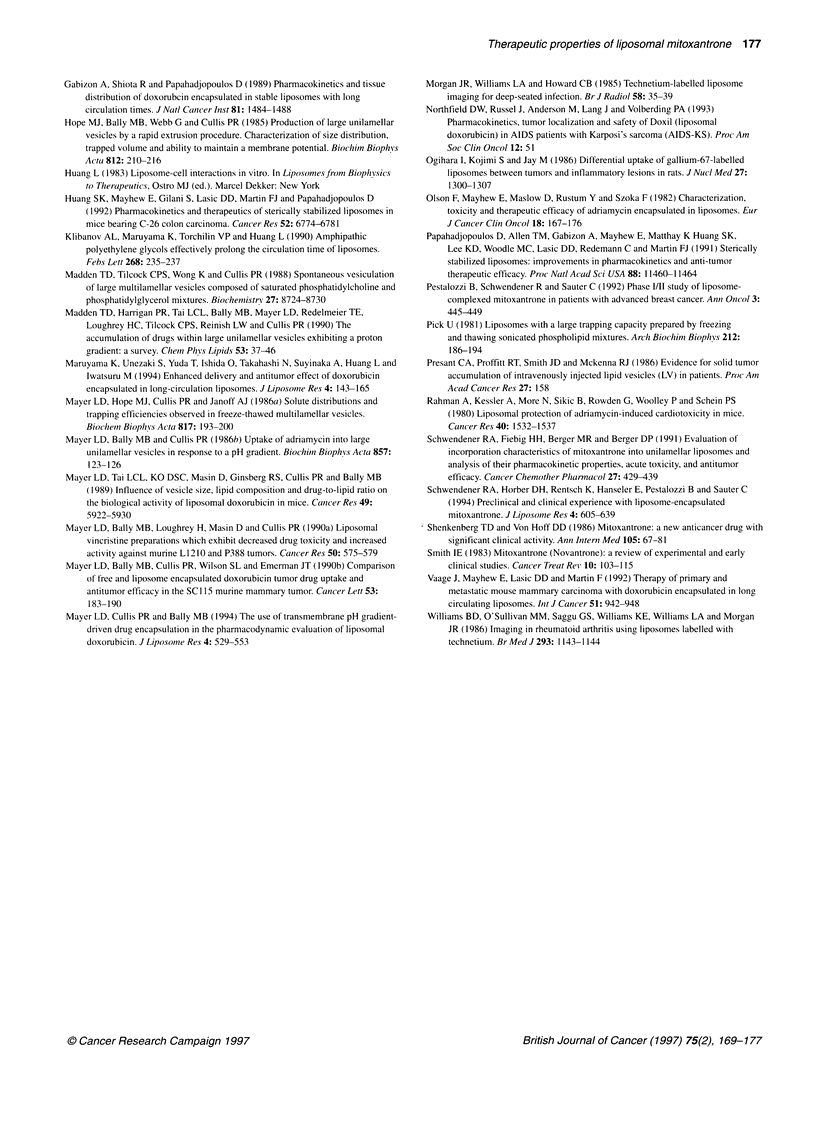
Selected References
These references are in PubMed. This may not be the complete list of references from this article.
- Allen T. M., Hansen C., Martin F., Redemann C., Yau-Young A. Liposomes containing synthetic lipid derivatives of poly(ethylene glycol) show prolonged circulation half-lives in vivo. Biochim Biophys Acta. 1991 Jul 1;1066(1):29–36. doi: 10.1016/0005-2736(91)90246-5. [DOI] [PubMed] [Google Scholar]
- Allen T. M. Long-circulating (sterically stabilized) liposomes for targeted drug delivery. Trends Pharmacol Sci. 1994 Jul;15(7):215–220. doi: 10.1016/0165-6147(94)90314-x. [DOI] [PubMed] [Google Scholar]
- Bally M. B., Masin D., Nayar R., Cullis P. R., Mayer L. D. Transfer of liposomal drug carriers from the blood to the peritoneal cavity of normal and ascitic tumor-bearing mice. Cancer Chemother Pharmacol. 1994;34(2):137–146. doi: 10.1007/BF00685931. [DOI] [PubMed] [Google Scholar]
- Boman N. L., Masin D., Mayer L. D., Cullis P. R., Bally M. B. Liposomal vincristine which exhibits increased drug retention and increased circulation longevity cures mice bearing P388 tumors. Cancer Res. 1994 Jun 1;54(11):2830–2833. [PubMed] [Google Scholar]
- Chonn A., Semple S. C., Cullis P. R. Association of blood proteins with large unilamellar liposomes in vivo. Relation to circulation lifetimes. J Biol Chem. 1992 Sep 15;267(26):18759–18765. [PubMed] [Google Scholar]
- Funato K., Yoda R., Kiwada H. Contribution of complement system on destabilization of liposomes composed of hydrogenated egg phosphatidylcholine in rat fresh plasma. Biochim Biophys Acta. 1992 Jan 31;1103(2):198–204. doi: 10.1016/0005-2736(92)90087-3. [DOI] [PubMed] [Google Scholar]
- Gabizon A. A. Selective tumor localization and improved therapeutic index of anthracyclines encapsulated in long-circulating liposomes. Cancer Res. 1992 Feb 15;52(4):891–896. [PubMed] [Google Scholar]
- Gabizon A., Dagan A., Goren D., Barenholz Y., Fuks Z. Liposomes as in vivo carriers of adriamycin: reduced cardiac uptake and preserved antitumor activity in mice. Cancer Res. 1982 Nov;42(11):4734–4739. [PubMed] [Google Scholar]
- Gabizon A., Papahadjopoulos D. Liposome formulations with prolonged circulation time in blood and enhanced uptake by tumors. Proc Natl Acad Sci U S A. 1988 Sep;85(18):6949–6953. doi: 10.1073/pnas.85.18.6949. [DOI] [PMC free article] [PubMed] [Google Scholar]
- Gabizon A., Shiota R., Papahadjopoulos D. Pharmacokinetics and tissue distribution of doxorubicin encapsulated in stable liposomes with long circulation times. J Natl Cancer Inst. 1989 Oct 4;81(19):1484–1488. doi: 10.1093/jnci/81.19.1484. [DOI] [PubMed] [Google Scholar]
- Huang S. K., Mayhew E., Gilani S., Lasic D. D., Martin F. J., Papahadjopoulos D. Pharmacokinetics and therapeutics of sterically stabilized liposomes in mice bearing C-26 colon carcinoma. Cancer Res. 1992 Dec 15;52(24):6774–6781. [PubMed] [Google Scholar]
- Klibanov A. L., Maruyama K., Torchilin V. P., Huang L. Amphipathic polyethyleneglycols effectively prolong the circulation time of liposomes. FEBS Lett. 1990 Jul 30;268(1):235–237. doi: 10.1016/0014-5793(90)81016-h. [DOI] [PubMed] [Google Scholar]
- Madden T. D., Harrigan P. R., Tai L. C., Bally M. B., Mayer L. D., Redelmeier T. E., Loughrey H. C., Tilcock C. P., Reinish L. W., Cullis P. R. The accumulation of drugs within large unilamellar vesicles exhibiting a proton gradient: a survey. Chem Phys Lipids. 1990 Mar;53(1):37–46. doi: 10.1016/0009-3084(90)90131-a. [DOI] [PubMed] [Google Scholar]
- Madden T. D., Tilcock C. P., Wong K., Cullis P. R. Spontaneous vesiculation of large multilamellar vesicles composed of saturated phosphatidylcholine and phosphatidylglycerol mixtures. Biochemistry. 1988 Nov 29;27(24):8724–8730. doi: 10.1021/bi00424a006. [DOI] [PubMed] [Google Scholar]
- Mayer L. D., Bally M. B., Cullis P. R. Uptake of adriamycin into large unilamellar vesicles in response to a pH gradient. Biochim Biophys Acta. 1986 May 9;857(1):123–126. doi: 10.1016/0005-2736(86)90105-7. [DOI] [PubMed] [Google Scholar]
- Mayer L. D., Bally M. B., Cullis P. R., Wilson S. L., Emerman J. T. Comparison of free and liposome encapsulated doxorubicin tumor drug uptake and antitumor efficacy in the SC115 murine mammary tumor. Cancer Lett. 1990 Sep;53(2-3):183–190. doi: 10.1016/0304-3835(90)90212-g. [DOI] [PubMed] [Google Scholar]
- Mayer L. D., Tai L. C., Ko D. S., Masin D., Ginsberg R. S., Cullis P. R., Bally M. B. Influence of vesicle size, lipid composition, and drug-to-lipid ratio on the biological activity of liposomal doxorubicin in mice. Cancer Res. 1989 Nov 1;49(21):5922–5930. [PubMed] [Google Scholar]
- Morgan J. R., Williams L. A., Howard C. B. Technetium-labelled liposome imaging for deep-seated infection. Br J Radiol. 1985 Jan;58(685):35–39. doi: 10.1259/0007-1285-58-685-35. [DOI] [PubMed] [Google Scholar]
- Ogihara I., Kojima S., Jay M. Differential uptake of gallium-67-labeled liposomes between tumors and inflammatory lesions in rats. J Nucl Med. 1986 Aug;27(8):1300–1307. [PubMed] [Google Scholar]
- Olson F., Mayhew E., Maslow D., Rustum Y., Szoka F. Characterization, toxicity and therapeutic efficacy of adriamycin encapsulated in liposomes. Eur J Cancer Clin Oncol. 1982 Feb;18(2):167–176. doi: 10.1016/0277-5379(82)90060-8. [DOI] [PubMed] [Google Scholar]
- Pestalozzi B., Schwendener R., Sauter C. Phase I/II study of liposome-complexed mitoxantrone in patients with advanced breast cancer. Ann Oncol. 1992 Jun;3(6):445–449. doi: 10.1093/oxfordjournals.annonc.a058232. [DOI] [PubMed] [Google Scholar]
- Pick U. Liposomes with a large trapping capacity prepared by freezing and thawing of sonicated phospholipid mixtures. Arch Biochem Biophys. 1981 Nov;212(1):186–194. doi: 10.1016/0003-9861(81)90358-1. [DOI] [PubMed] [Google Scholar]
- Rahman A., Kessler A., More N., Sikic B., Rowden G., Woolley P., Schein P. S. Liposomal protection of adriamycin-induced cardiotoxicity in mice. Cancer Res. 1980 May;40(5):1532–1537. [PubMed] [Google Scholar]
- Schwendener R. A., Fiebig H. H., Berger M. R., Berger D. P. Evaluation of incorporation characteristics of mitoxantrone into unilamellar liposomes and analysis of their pharmacokinetic properties, acute toxicity, and antitumor efficacy. Cancer Chemother Pharmacol. 1991;27(6):429–439. doi: 10.1007/BF00685156. [DOI] [PubMed] [Google Scholar]
- Shenkenberg T. D., Von Hoff D. D. Mitoxantrone: a new anticancer drug with significant clinical activity. Ann Intern Med. 1986 Jul;105(1):67–81. doi: 10.7326/0003-4819-105-1-67. [DOI] [PubMed] [Google Scholar]
- Williams B. D., O'Sullivan M. M., Saggu G. S., Williams K. E., Williams L. A., Morgan J. R. Imaging in rheumatoid arthritis using liposomes labelled with technetium. Br Med J (Clin Res Ed) 1986 Nov 1;293(6555):1143–1144. doi: 10.1136/bmj.293.6555.1143-a. [DOI] [PMC free article] [PubMed] [Google Scholar]


